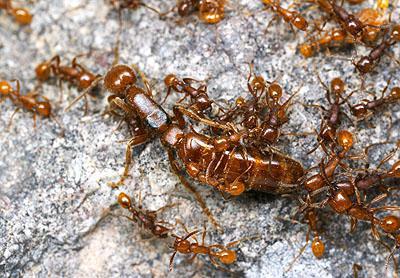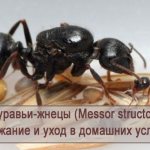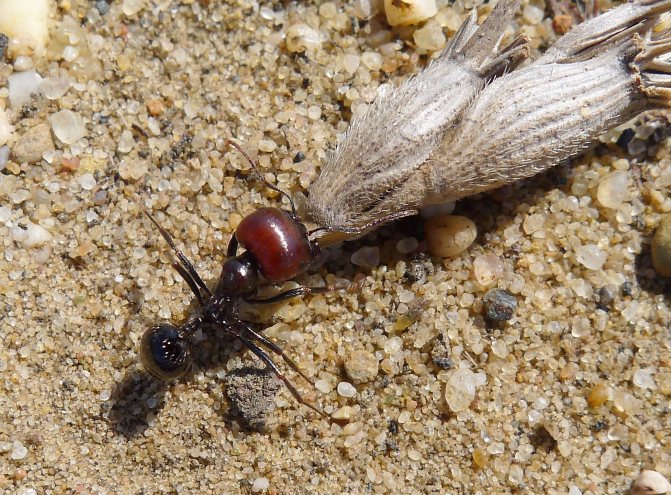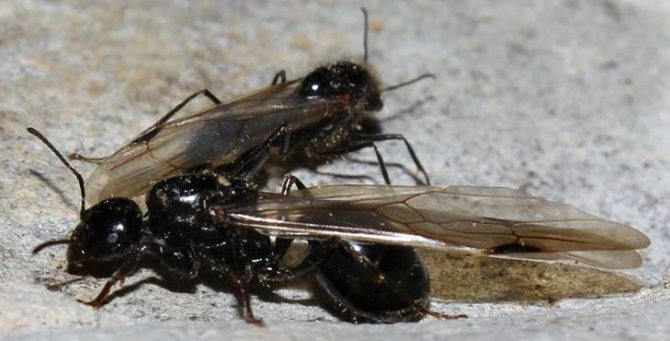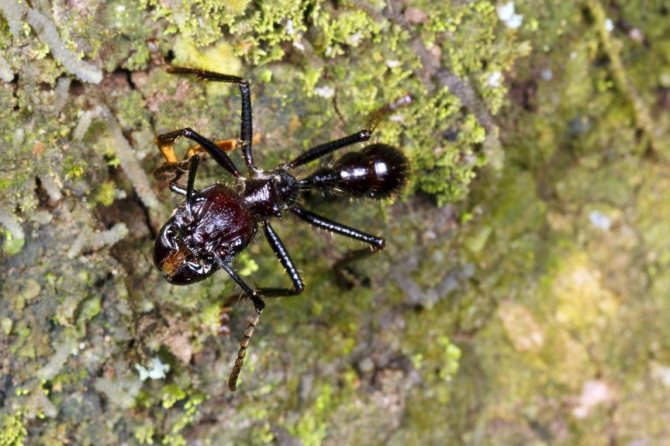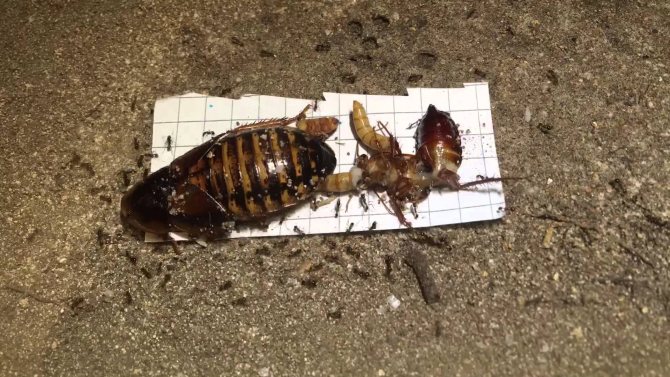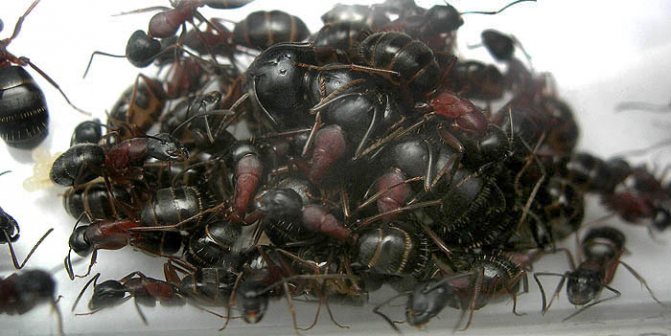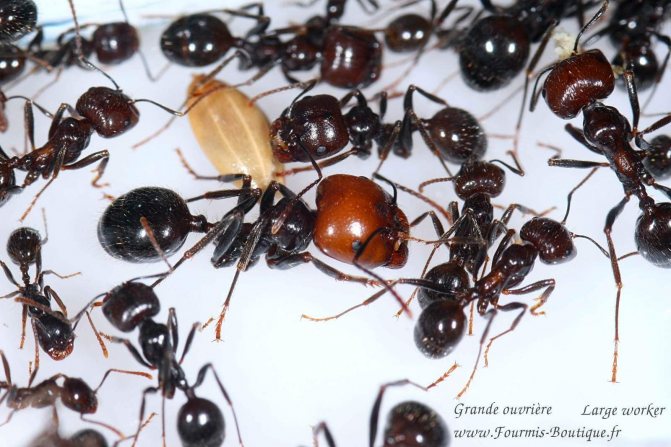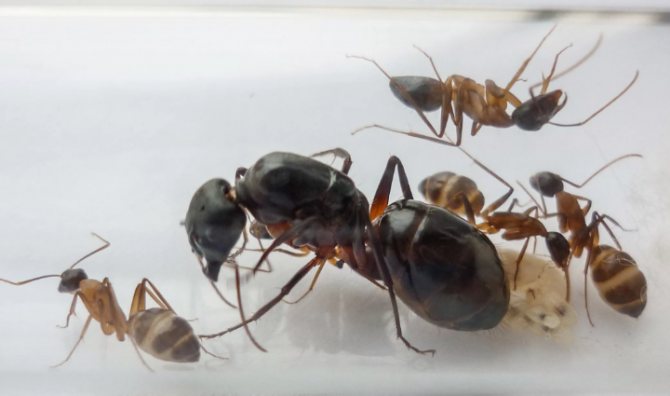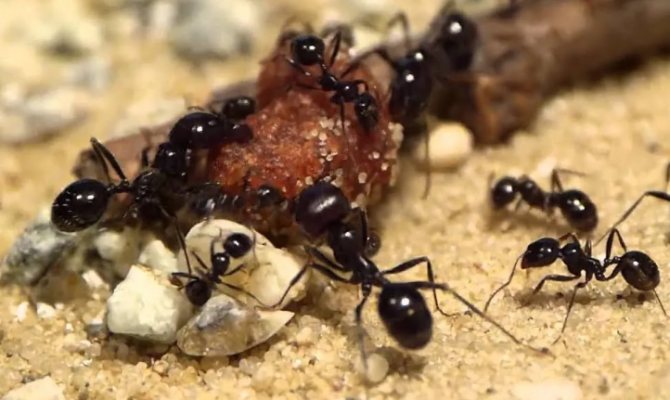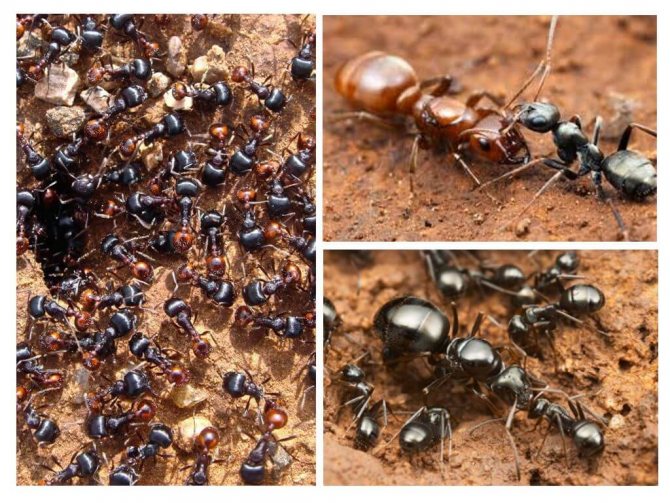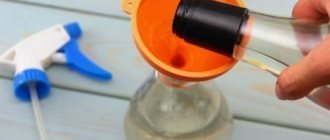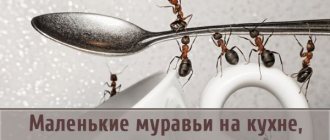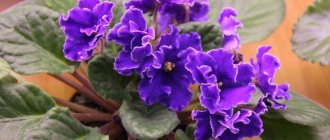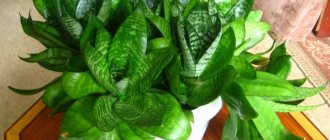The creation of an ant farm at home or in the office is becoming more and more popular. Unpretentious reaper ants are best suited for this. Before you start these insects, you should familiarize yourself with their specific features: everyday life, habitat, exterior, breeding and maintenance features.
Features of the view
Insects have different body colors - black, brown, reddish. Body length 4 to 9 mm maximum. Females are several times larger than males. Workers are somewhat different in structure. In the anthill there is a clear division into castes, with a large number of "professions". Babysitters, midwives, transporters, guards, warriors, food givers, warehouse keepers, and so on.
Places where reaper ants live, with an arid climate - Asia, Africa, America, Southern Europe. Inhabitants of desert, semi-desert regions. The steppe reaper ant builds colonies from 500 individuals to 50,000. It prefers to be found near fields with cereals. In search of food, he goes 80 m from the anthill.
Behavior and activity
In general, reapers are a fairly calm and non-aggressive genus of ants. In nature, they never attack other anthills, they only defend their own forage territory. They can lay long enough forage roads, and organize a multi-section nest. At home, with the growth of the colony, aggressiveness and activity grows, and if the arena is not large enough or the ants lack something (seeds or water), they begin to climb through the anti-escape, but overcome it very rarely and with great difficulty.
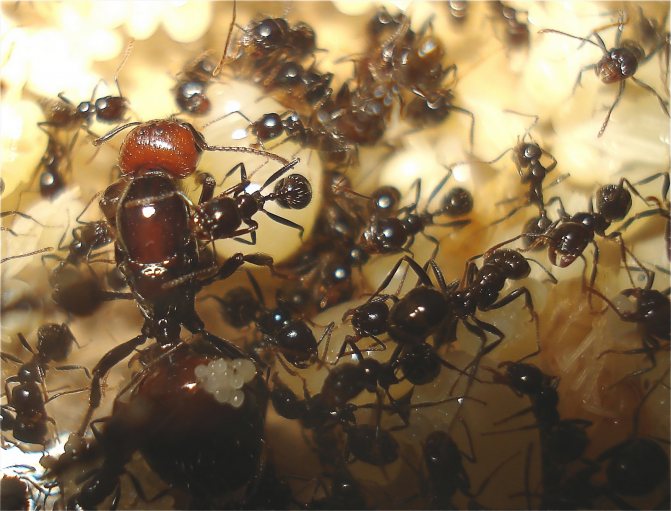
Home colony Messor barbarus
Procuring food
For a long time, it was believed that messor structor ants were agricultural pests, since large reserves of wheat, barley, millet, and millet grains were found in their anthill. Later, it became known what ants eat, how they collect seeds.
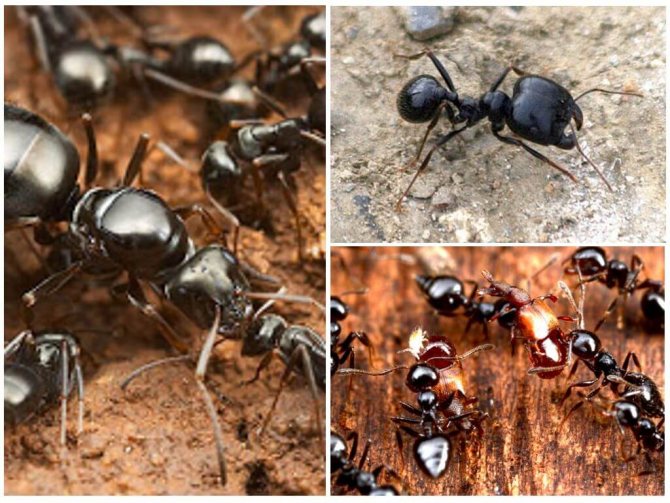

Reaper ants The peculiarity is that reaper ants collect grains from the ground without touching the growing ear. The “harvest” is picked up after the activity of the harmful turtle, mice and other pests.
Interesting!
Numerous chambers for storing grain are built in the anthill. Up to 50 kg of grains can be harvested in one season. An insect can eat all this in one season. In tropical countries, numerous ant stocks are often the subject of controversy. Who owns the found grain - the owners of the field where the anthill is located, or the owner of the land from where the reapers dragged the harvest.
In search of food, the ant family sends out a different number of messengers. How many of them are required depends on the speed of return of the sent family members. If the harvest is plentiful, the ants return quickly, bringing in large supplies.
In distress, the ant is absent for a long time in the fields; after its return, a smaller number of individuals are sent to the fishery. Gradually reducing the number to zero.
Maintenance and care at home
Maintenance, caring for ants is within the power of both experienced myrmikers and beginners. Having created comfortable conditions, there is practically no need to care for the reapers. With a supply of water and feed, the ant farm can easily endure the absence of a person for several weeks. In addition, they are peaceful and do not require wintering.


Colony start
Since the queen establishes a colony on her own, the standard colony raising scenario is used. The queen is placed in an incubator and removed to a dark place before the first workers appear.
Incubator, Formicarium, Arena
Incubator
For the starting colony, a standard tube or syringe incubator is used. Subsequently, as the number increases, the feeding arena is attached to the incubator. You can also install an additional dry test tube for storing seeds.
Formicaria
It is recommended to keep the reapers in gypsum and aerated concrete formicaria, preferably of the horizontal type, this is due to the need for large areas for storing grain. In formicaria of this type, a moisture gradient is formed - in dry chambers ants will store seeds, in moist chambers they will germinate seeds, in chambers with moderate humidity the bulk of ants live, brood is stored, etc. The moisture gradient is extremely important for reapers! When pouring a plate of formicaria, it must be borne in mind that the reapers gnaw plaster very well. This problem can be solved by adding cement to the mixture, thereby increasing the strength of the board. If you do not do this, it is necessary to place cameras and passages further from the communications of the formicaria. Especially from the humidification chamber, otherwise the ants can gnaw the tunnel to the water and cause flooding.
Arena
It is not recommended to use sand or earth as soil - the ants will cover the glass with them in the formicaria, reducing visibility to almost zero, and, moreover, they will regularly fill up the entrance to them. You can either just leave the plastic (glass), or fill the arena with a thin layer of plaster. Systematic cleaning of the arena is required! Reapers, due to their special diet, produce a lot of organic debris (husks) that can rot and cause mold. It is imperative to place a drinker in the arena. (at least a piece of a syringe with a cotton swab).
Anti-escape
The edges of the arena can be lubricated with petroleum jelly (or a similar protective mixture), and then it can be kept open. On some plastics, reapers generally do not know how to walk vertically.
The content of ants of this species has its own characteristics:
- an ant farm is a very exciting project, but you shouldn't light it up at night, shake it, disturb insects. This slows down the development of the colony, the ants become shy;
- high humidity causes the death of reaper ants;
- these insects store large volumes of grain, they need a larger nest for keeping than for other ants;
- when the protein content in food decreases, the ants breed special feeding larvae, then eat them;
- you cannot feed the reapers with syrup.
- Low-quality protein - it is better to keep the reapers on grains alone than to give various human food, etc.
- You should not throw dolls of your own kind to the reapers - they will still eat most of them.
- Careless handling - reapers have a rather fragile physique, despite their large heads and a seemingly menacing appearance. If possible, it is better not to take these ants in your hands, and in case of escape, use an exhauster. Uterus require special care - cases have been described when the uterus died after such injuries.
Power features
Unlike other species, reaper ants feed exclusively on plant foods. Even the larvae are fed with grain, while representatives of other species require the juices of other insects.
The reserves are monitored very carefully. During germination of grains, starch turns into sugar, which is of particular value for the ant family. The workers quickly gnaw off the roots and sprouts, and the stocks are carefully sorted out. The larvae are fed with ground flour.
How long does a queen ant live?
So how long does a queen ant live? Unfortunately, it is rather difficult to give an exact answer to this question: it depends very much on the type of insect.There are species whose queens live as long as not every cat or dog will last - 20 years ... Just think about this figure! True, the female pharaoh ants, which people most often want to get rid of, are still not record long-livers: their life expectancy is a maximum of 2 years under favorable conditions.
By the way
Red ants are the kind that are often found in the middle lane, but in natural conditions, and not indoors. This is a completely different species, not related to domestic pest ants.
On average, the queens of a colony live about 10 years, which is several times longer than the life expectancy of an ordinary worker, but do not think that the queen of ants is the center of the universe for the colony. It is the ordinary worker ant that regulates the life of the anthill, so that these hard workers can easily kill an unwanted queen if its productivity has dropped significantly or one of several queen bees is at the moment surplus.
And yes, in ant colonies there are often several queens: they can stay in the family in which they appeared, or they can move out, forming a new colony. This is why it is so difficult to deal with domestic pharaoh ants: by destroying one nest, you leave untouched others, the existence of which you may not even suspect.
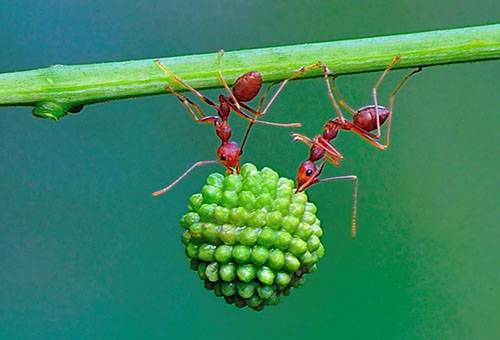

Reproduction


Reproduction of ants In young females, males, wings grow during the mating period. Flying ants spend their mating season in the air. Males soon die, females go deep into the ground, lay eggs. Working individuals are born of them, which are taken for the arrangement of a new anthill.
Interesting!
One fertilization of the uterus is enough to reproduce offspring throughout its life. How long reaper ants live depends on the caste to which they belong. The queen is capable of living for 28 years, individuals working in an anthill for 5 years, working ants for a maximum of 3 years.
Food addiction
Reaper ants got their name for a reason. Their collective farm has a pronounced grain specificity.
Foragers collect grains of wheat, rye, oats, barley, as well as seeds of other plants, which have fallen out of spikelets in the steppe.
Further, other ants crush these seeds into small pieces. Having passed through the grain processing conveyor, the seeds are ground into flour, moistened with the saliva of numerous workers and fed to the larvae.
This grain specialization does not exclude the availability of animal feed. On occasion, a well-organized crowd of foragers will drag some dead insect into the anthill. If necessary, they do not disdain hunting, using their ant methods of collective fishing.
The grain advantage of ant farming is related to the habitat. This species lives in arid herbaceous communities, mainly in steppes and semi-deserts. Such natural zones are formed mainly by cereals, which, as is known, have a large number of large and hard seeds.
Larval development
Individual individuals take care of the eggs, move them to separate chambers, and monitor the observance of favorable conditions. The division into castes occurs already during the hatching of the larvae. Which of them will be who in society depends on the amount of food consumed.
The larvae are not able to move independently, to eat. All this is provided by the breadwinners, nurses. The young growth is constantly increasing in size, pupates after 1-2 months. The pupa does not have a dense shell; it is possible to trace the development of insects. At the last stage, it begins to move, a full-fledged insect appears.
Ant and anthill
In the families of these ants, polymorphism is well developed. There are not only workers, soldiers, nannies, but also several transitional forms.This diversity is due to the fact that the grains of plants for the most part are too large and hard for ants.
Reaper soldiers have very large heads, not only for fighting rivals in duels, but also because these jaws are necessary for the primary crushing of grains.
People encounter predominantly forage worker ants, which scatter long distances in search of food sources. You can meet with big-headed soldiers only near the anthill. Insect families have a very strict discipline. Here, everyone behaves in accordance with the function that the community needs so much.
Reaper families are small: only about 5 thousand individuals in a developed anthill. You can't build a big dwelling with that amount. Reapers' nests do not have domes familiar to the human eye. Among a flat surface, such an anthill can only be recognized by a small earthen mound with characteristic debris accompanying the transportation of seeds.
The main room is a long tunnel that slopes down almost vertically. Passages with cameras depart from it in different directions. In large anthills, 2-3 such sections are usually formed, small anthills bypass one.
Some interesting facts
- Some of the species of these arthropods can be under water without air access for 4 days, as if in a conserved state. Extracted from the liquid, they come to life again and continue to exist.
- The legs of the ant (there are 6 of them, and each has 3 joints) are very strong. They are, as it were, designed by nature for hard work and moving loads. By the way, if this insect was as tall as people, then in proportion to physical data it could run at a speed of up to 60 kilometers per hour and lift loads of one and a half tons!
- Ants, according to some researchers, have a collective intelligence, and the total number of their brain cells (for a single anthill) is comparable to the number of the same cells in humans.
Complete transformation
In the anthill, life boils and is constantly renewed. Like any insect, this forest orderly goes through a series of transformations in his life. Moreover, the stages of his life are significantly different functionally and externally. There are four known stages of ant development:
- egg;
- larva;
- chrysalis;
- an adult (imago).
That is, all species of ants belong to insects with a complete transformation cycle, which is called holometabolism. As a rule, in most species, the entire development process takes about a month.
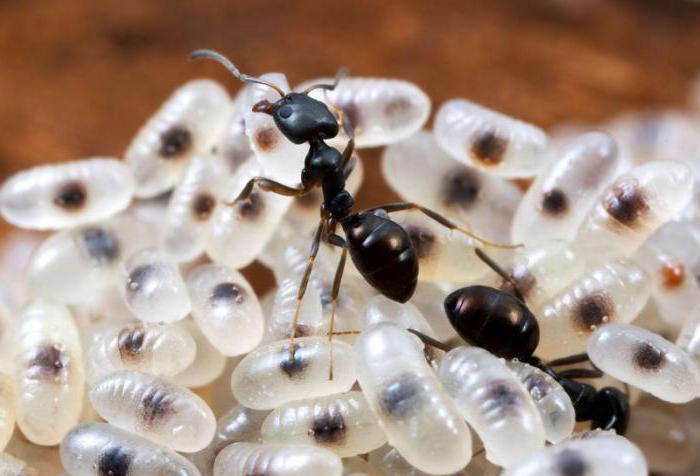

Adult
An adult ant (imago) emerges from the cocoon at the end of its development. Scientists have learned that a young individual is pulled out of the shell by congeners - working ants, since it cannot open the cocoon on its own. At the beginning of the journey, an adult ant has a lighter color, and after a few days it already acquires a body color that is indistinguishable from the rest. Since then, the worker ant does not grow, but feeds mainly on carbohydrate food. This is how the stages of ant development are completed.
